Modular Drainage
Physical Properties, Installation Guides
Ausdrain HexCell Drainage Cell
Ausdrain modular drainage cells provide a permanent non-clogging void between the building structure and the soil profile allowing an undisrupted flow of excess water to designated outlets.
The smooth surface of the modules protects the waterproof membrane and the 30mm void enables efficient discharge of water and ventilation to the slab surface.
The use of Ausdrain Modules and Filter Fabric in conjunction with a waterproof membrane creates a complete waterproofing and drainage system.
Ausdrain 30mm drainage cells provide a permanent, structural and non-clogging void between the building structure and the soil profile that will not collapse or distort. The void enables a direct flow of water to designated outlets resulting in superior drainage efficiency compared to conventional gravel filled systems.
Horizontal Drain
- Roof gardens
- Planter boxes
- Podium landscaping
- Sports fields
- Civil works
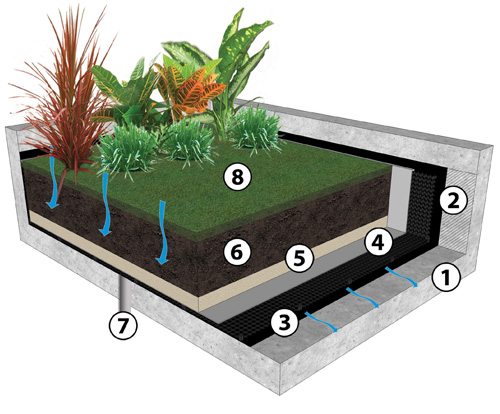
Horizontal Drain
- waterproof membrane
- protection board
- drainage cell
- geotextile fabric
- course washed river sand
- soil mix
- outlet pipe
- planting/ landscaping
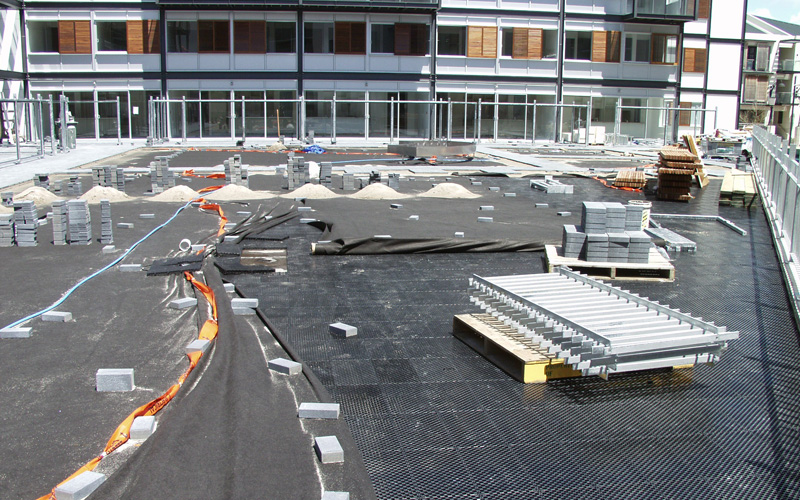
Horizontal Drain
Wall Drain
- Basements
- Underground carparks
- Foundation walls
- Bridge abutments
- Tunnels
Basement Walls and Retaining Walls constructed underground come into contact with water conductive earth. Penetrating water has a tendency to find any possible points of weakness sometimes resulting in widespread and often irreparable damage. The collection and build up of ground water also creates a great deal of hydrostatic pressure placing large stresses on wall structures. The Ausdrain Wall Drainage System provides the ultimate solution to these problems.
Vertical wall drain panels create a structural void between the wall and the backfilled area. Syntex geotextile surrounding the panels allows water to filter into the void, prevents sediment from entering the system and cushions the waterproof membrane.
Water entering the system experiences an undisrupted flow that feeds directly into the Ausdrain Filter Pipe where it is discharged to designated stormwater outlets. The result is a continuous discharge of water preventing any water from coming into contact with the wall surface and also providing relief from hydrostatic pressure.
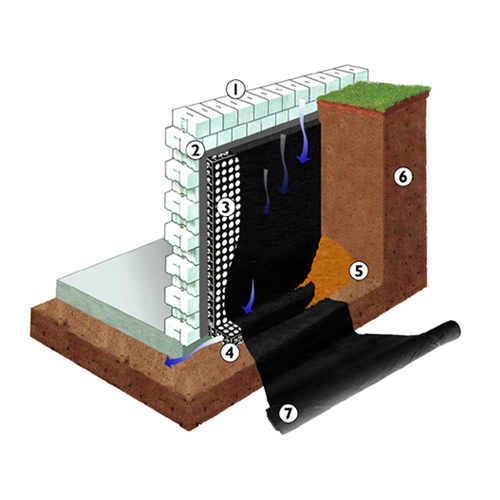
Wall Drain
- basement brickwork
- waterproof membrane
- wall drain panels
- filter pipe
- course washed river sand
- clean backfill
- filter fabric
- Syntex Filter fabric wrapped on both sides
- 30 mm core (void)
- Efficient water collection through the vertical void
- Undisrupted flow of filtered water to designated outlets or sumps
- High compressive strength withstands ground and structural movement
- Acts as the secondary membrane protection layer
- Eliminates the need for gravel as the primary back-fill material
- Maintains a dry structure as water is unable to penetrate to the wall
- Void separation facilitates ventilation to the wall
- Rigid modular panels sit completely flush against the wall during installation
- Light weight and easy to handle and install
- Durable and cost effective
Ausdrain Envirotank
Ausdrain EnviroModules provide a simple, strong and effective solution to on-site stormwater management, septic tank dispersal and environmental management. Rainwater Harvesting Stormwater Re-Use Stormwater Infiltration Stormwater On-site Detention Stormwater Bio-Remediation Stormwater Filtration. The high compressive strength modular crates allow the construction of in-ground structures with minimum visual impact, but maximum effect and site utility.
The Modules are assembled as 450 x 400 x 600 mm crates and can be stacked (and connected) together to form structural underground tanks. Ausdrain® Tank Modules are manufactured from 100% recycled plastics and are environmentally friendly.
Rainwater Harvesting Residential
The Ausdrain EnviroModule Re-use System offers an underground storage and re-use of rainwater. This water can then be effectively reticulated for household purposes such as toilets, laundry, car washing, swimming pool and garden hosing.
The system is supplied as a complete package including a submersible pump and utilises the Davey Rainbank, that senses when the tank is near empty and automatically switches the flow of water from tank to mains supply. This can provide potential water saving benefits of up to 40%.
The system is available as a stock item in ready to order sizes ranging from 2500 litres to 20000 litres in capacity. Larger sized tanks can be supplied on request and above ground pumps may also be incorporated as an option.
Ausdrain EnviroModule tanks can be supplied to specific dimensions to suit individual site requirements and can be installed under trafficable areas such as driveways allowing greater use of land area and design flexibility.
Rainwater Harvesting Commercial
Ausdrain tanks can be installed in landscaped areas and under trafficable areas such as a driveway or carpark where external space is limited. When installed in a trafficable area, a pavement consisting of stabilised road base and asphalt or a reinforced concrete slab is required over the surface of the tank according to engineer’s specification.
The Ausdrain tank is recommended for car and light commercial vehicle traffic. The tank can be designed for heavy vehicle traffic in certain situations. The AUSDRAIN EnviroModule tank is surrounded in a durable, high tensile strength, factory welded waterproof liner manufactured by Permathene. The liner is supplied as a base and cap and is made to order according to specific tank dimensions. The cap overlaps the base and does not require joining or sealing on site, ensuring that each tank is completely watertight. Our specialist liner installers can also weld the liners on-site ensuring maximum sealing of the liner and connections.
Inlets and outlets connect to a pre-cast pit. This pit acts as a maintenance and inspection chamber for the tank and houses either a suction line connected to an above ground pump or a submersible pump. It is essential that water entering the tank is pre-filtered to avoid long term maintenance of the tank.
Either an Ausdrain EnviroSump(s) or a suitable Gross Pollutant Trap (GPT) should be installed to prevent sediment and gross pollutants from reaching the tank. In the event that the tank surcharges, excess water is discharged through an overflow pipe to a designated stormwater outlet.
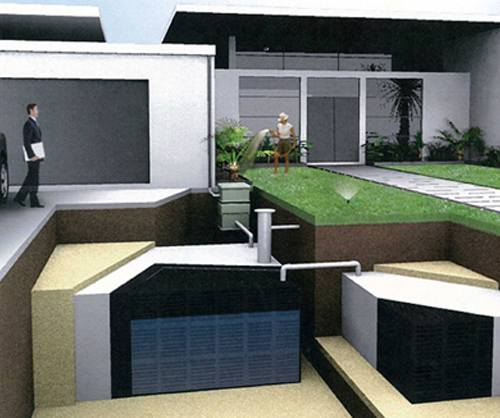
Rain Harvesting Residential
- downpipe
- inlet pipe
- discharge control pit
- lockable lid/ gate
- Enviromodules
- welded tank liner
- protection fabric
- overflow pipe
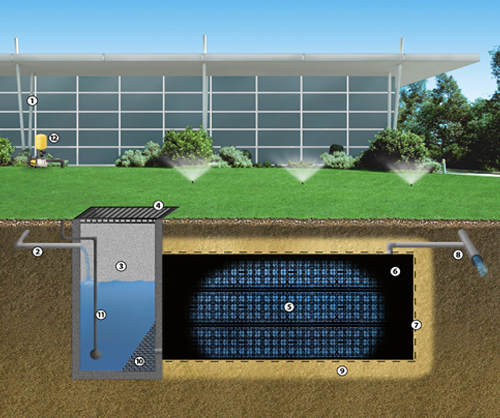
Rain Harvesting Commercial
- downpipe
- inlet pipe
- discharge control pit
- lockable lid/ gate
- Enviromodules
- welded tank liner
- protection fabric
- overflow pipe
- course sand backfill
- screen
- suction line
- above ground pump
Modular Tanks On-site Detention
AUSDRAIN EnviroModule2 Detention Tanks can be easily installed on any project, saving valuable time, labour and money. Compared to a concrete tank, there are no footings/slabs, blockwork or reinforcement required. Each tank is sealed with a strong and durable Permathene manufactured waterproof liner.
AUSDRAIN EnviroModules create the required void storage allowing stormwater to be temporarily stored inside the tank before discharging to a designated outlet. AUSDRAIN EnviroModules are available in standard duty, suitable for installation under landscaped areas, or extra duty, for trafficable situations such as carparks or driveways.
The modular nature of the tank allows greater scope for design flexibility and tank sizing. Stormwater is pre-filtered via an EnviroSump or GPT. This provides valuable at source water quality benefits and reduces the need for long-term tank maintenance. The water then enters a pre-cast pit that is fitted with an orifice plate to reduce the rate of discharge from the tank to the designated stormwater outlet.
AUSDRAIN EnviroModule2 detention tanks are available from small tanks for residential projects, to large detention systems for commercial applications. Council approval should always be sought prior to installation.
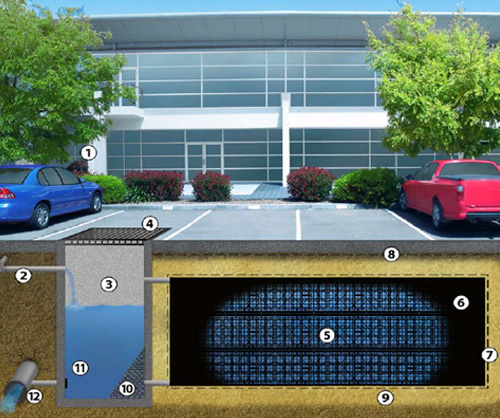
On-site Detention
- downpipe
- inlet pipe
- discharge control pit
- lockable lid/ gate
- Enviromodules
- welded tank liner
- protection fabric
- geogrid under carpark
- course sand backfill
- screen
- orifice plate
- outlet to stormwater
Infiltration Tank
Compared to conventional gravel systems, the AUSDRAIN EnviroModule2 Infiltration Tank offers 95% void storage that reduces tank sizes by up to two thirds, saving on excavation and spoil removal costs.
The continued development of our cities and greenfields has resulted in the requirement for on-site stormwater management. The implementation of an infiltration system assists with the replenishment of underground aquifers and prevents stormwater discharge that may result in downstream flooding. The AUSDRAIN EnviroModule2 Infiltration Tank has proven to be one of the most efficient and cost-effective solutions to the environmental issues of stormwater management that have resulted in local authority requirements for infiltration tanks or soakaways.
The EnviroModule2 Tank is constructed from high strength EnviroModules that have been engineered to allow stormwater to be captured and efficiently discharged inside a structural void surrounded in geotextile fabric. Water entering the tank is stored temporarily and naturally dissipates back into the surrounding ground at a rate dependent on soil type.
The AUSDRAIN EnviroModule2 tank can be installed in a variety of soil types due to the remarkable infiltration rates proven to be up to six times greater than gravel filled systems. The high compressive strength of the modules enables tank installations under trafficable areas such as carparks and driveways. Pre-filtering of stormwater is essential for a well-designed system. Combined with the AUSDRAIN EnviroSump or a suitable Gross Pollutant Trap (GPT), this system provides a complete stormwater management solution.anks are available from small tanks for residential projects, to large detention systems for commercial applications. Council approval should always be sought prior to installation.
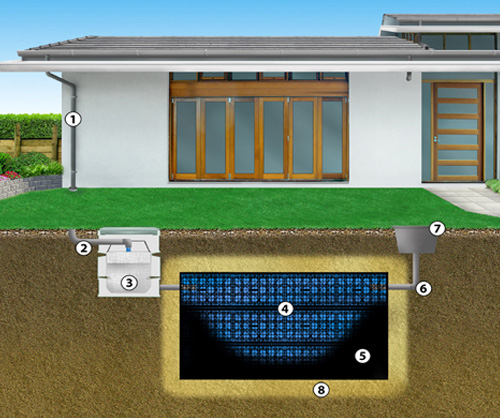
Infiltration Tank
- downpipe
- inlet pipe
- discharge control pit
- lockable lid/ gate
- Enviromodules
- welded tank liner
- protection fabric
- geogrid under carpark
- course sand backfill
- screen
- orifice plate
- outlet to stormwater
Bio-Remediation
Stormwater flowing from roadways, carparks and pavement contain toxic and gross pollutants. Heavy metals such as zinc, copper and lead are deposited on our roadways and are washed into the stormwater drains with each rainfall. Other stormwater pollutants include nutrients from decaying organic matter, detergents and pathogens from animal waste.
Without proper management this polluted water will end up in our oceans and waterways seriously impacting aquatic eco-systems. Gross Pollutant Traps (GPT’s) are effective in capturing solids such as litter, sediment and organic waste. However, in most cases it is not possible to treat stormwater for nutrients and heavy metals using such systems. A secondary stage of filtration is required based on treatment techniques used by other technologies such as constructed wetlands, sand filters and bio-retention systems.
AUSDRAIN™ EnviroModules can be effectively used to create a secondary treatment system. This system has proven to be extremely effective in the treatment of stormwater run-off. During light to medium rainfall all stormwater is directed to the system for treatment. During large storms the system adequately treats the initial “first flush” runoff containing the major concentration of pollutants.
The AUSDRAIN EnviroModule2 Bio-Remediation system has been effectively used to treat the run-off from roads and carparks when installed underneath a Rain Garden and has provided vital ecological and water quality benefits in environmentally sensitive areas.
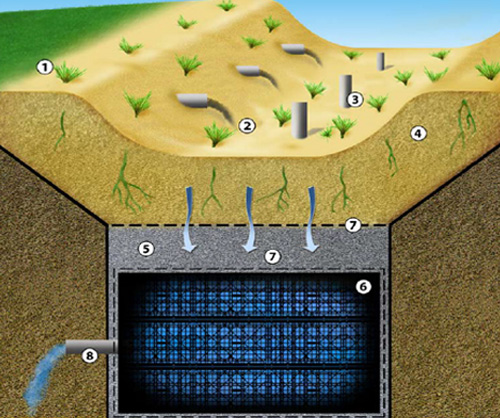
Bio-Remediation
- vegetation
- untreated stormwater
- inspection point
- course washed river sand
- lean 7mm gravel
- EnviroModules
- geotextile fabric
- clean stormwater
